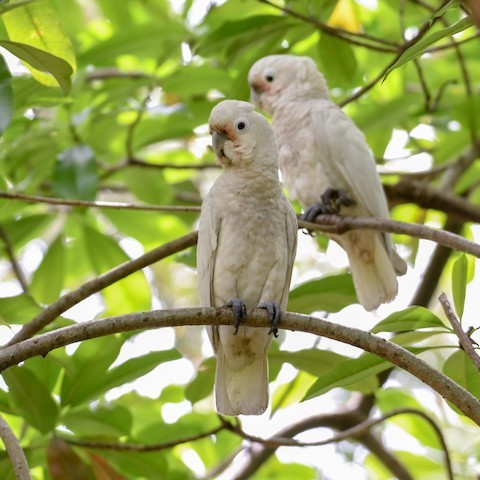Birdfinding.info ⇒ Despite persistent persecution for the pet trade, reportedly remains common across most of its small natural range in the Tanimbar Islands. In Singapore, introduced birds can be found in the Changi district (including Pasir Ris Park), Sentosa Island, Southern Ridges, King Albert Park, and Singapore Botanical Gardens. In Taiwan, flocks have been reported roosting at Taipei Botanical Garden, in Kaohsiung at National Sun Yat-Sen University and Cheng-Ching Lake, and around Lantan Lake east of Chiayi. In Hawaii, a few escapees have been found above Honolulu at the Lyon Arboretum and on the Big Island at Kaloko Mauka.
Tanimbar Corella
Cacatua goffiniana
Endemic to the Tanimbar Islands: Yamdena, Larat, and Selaru, where it occurs in all forest types.
It has been heavily persecuted for the cagebird trade (up to 10,000 captured annually), but the wild population has remained robust into the 2000s: estimated at 300,000-400,000.
An introduced population is well-established in Singapore. Smaller populations are more tenuously established on Tual (in the Kai Islands, northeast of the Tanimbars), Taiwan (multiple flocks reported in Taipei, Chiayi, and Kaohsiung), and Hawaii (Oahu and the Big Island).
Identification
A small white cockatoo with a pale ivory or horn-colored bill, pinkish lores, and a “saucer-eyed” appearance. Nearly identical to its sibling species, the Solomons Corella (see below for a more detailed comparison) of the Solomon Islands.

Tanimbar Corella, pair, showing pinkish flush throughout plumage and more pronounced pink on the lores. (Singapore; February 15, 2007.) © Jonathan Cheah Weng Kwong
Most of the plumage appears either white or slightly dingy off-white, with a pinkish blush overall. The feathers around the base of the bill in front of the eyes (i.e., roughly the lores) usually a darker reddish or brownish pink.
Bare white orbital skin makes its eyes appear exceedingly large.
It has a medium-sized crest that it usually keeps lowered. When raised, it can extend two or three inches above the head.
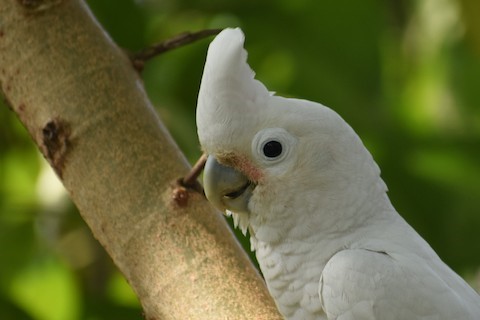
Tanimbar Corella, with crest raised. (Telok Blangah Hill Park, Singapore; January 17, 2019.) © John Marriott

Tanimbar Corella with crest lowered—note distinctly pink lores. (Changi, Singapore; February 27, 2007.) © Mervin Quah
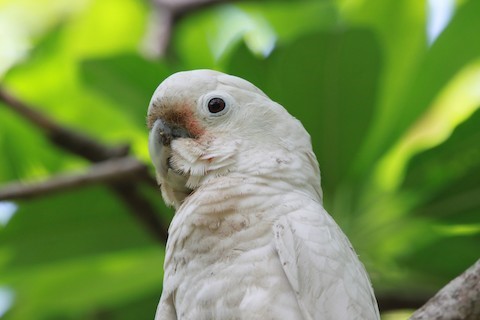
Tanimbar Corella. (Pasir Ris Park, Singapore; August 26, 2018.) © William Mahoney
As in other white cockatoos, the undersides of the wings and tail are suffused with yellow.
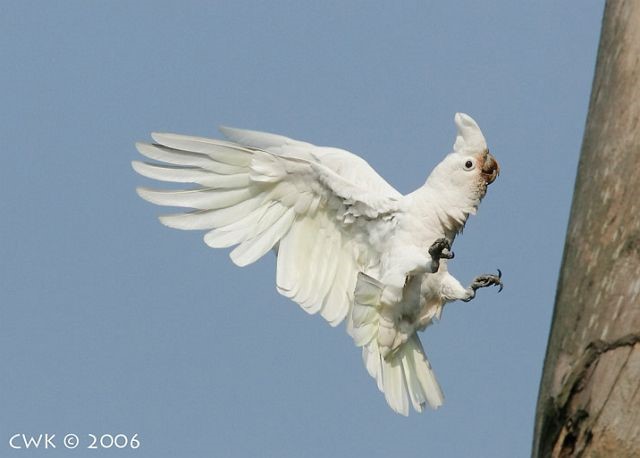
Tanimbar Corella. (Singapore; 2006.) © Jonathan Cheah Weng Kwong
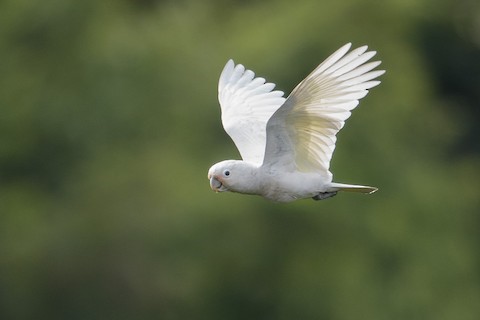
Tanimbar Corella. (Henderson Waves, Singapore; November 26, 2017.) © Francis Yap

Tanimbar Corella. (Yamdena, Tanimbar Islands, Maluku, Indonesia; July 21, 2009.) © Jon Hornbuckle
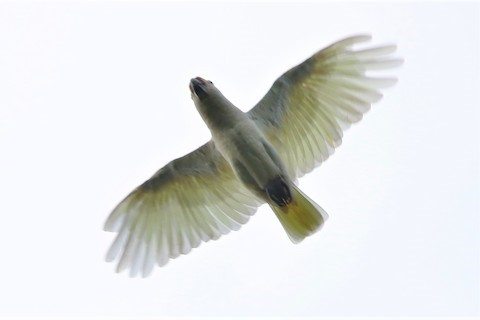
Tanimbar Corella, showing yellow on wings and tail. (Pasir Ris Park, Singapore; July 22, 2018.) © Ko Cheng
Notes
Monotypic species. Also known as Goffin’s Cockatoo—especially in aviculture.
IUCN Red List Status: Near Threatened.
See below for comparisons of Tanimbar Corella with Solomons Corella and White Cockatoo.
Cf. Solomons Corella. Tanimbar and Solomons Corellas are closely-related, nearly-identical sibling species that do not occur together naturally, but as escaped cagebirds might overlap almost anywhere. They are almost exactly the same size, shape, and colors—with mostly whitish plumage, a yellowish wash on the underwings and undertail, and pale, ivory or horn-colored bills. The visual differences between them are slight and difficult to ascertain.
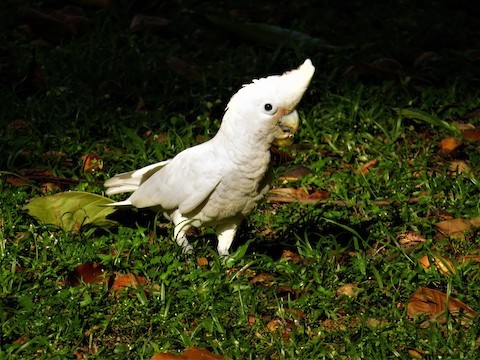
Tanimbar Corella showing big-eyed impression and pink in the lores. (Changi Point, Singapore; February 22, 2020.) © Evelyn Lee

Solomons Corella, showing pale bluish “goggle-eyed” impression and a pinkish flush on the face. (Tetepare, Solomon Islands; June 16, 2019.) © Devon DeRaad
Orbital Skin Color: Tanimbar Corella has white orbital skin, whereas Solomons’ tends to be either grayish or bluish. The difference in shading between white and grayish is slight, but the difference in overall appearance is fairly consistent. On Tanimbar, the white orbital skin gives the appearance of unnaturally big eyes, like a child’s toy. On Solomons, the grayish orbital skin gives the appearance of goggles around normal-sized eyes.
Lore Coloration: Tanimbar Corella usually has pinkish feathers beside the base of the bill, most pronounced around the lores. Solomons generally lacks this feature—its lores are whitish, matching the rest of its plumage.
Vocalizations: The typical calls of Tanimbar and Solomons Corellas seem to differ. Tanimbar tends to give harsh, screechy, monosyllabic calls. Tanimbar appears to have a more diverse repertoire, across a wider range of pitches, some harsh and some not, often repeating brief phrases.
Cf. White Cockatoo. White Cockatoo and Tanimbar Corella are similar species that are endemic to nearby islands in eastern Indonesia. They do not occur together naturally, but as popular cagebirds both can occur anywhere (climate permitting), which sometimes happens in Singapore and Hawaii.
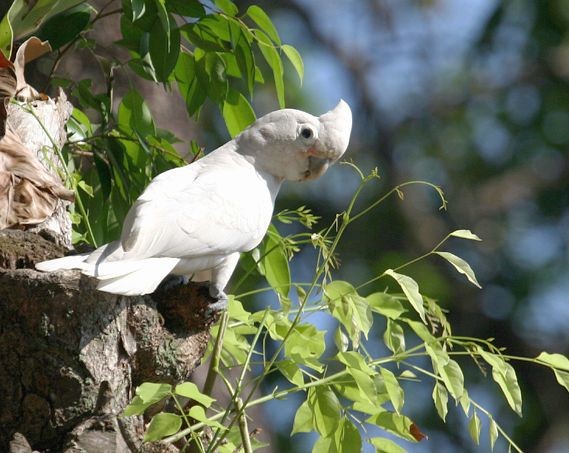
Tanimbar Corella, appearing nearly all-white—note horn-colored bill and pink feathers in the lores. (Changi, Singapore; April 15, 2005.) © Mervin Quah
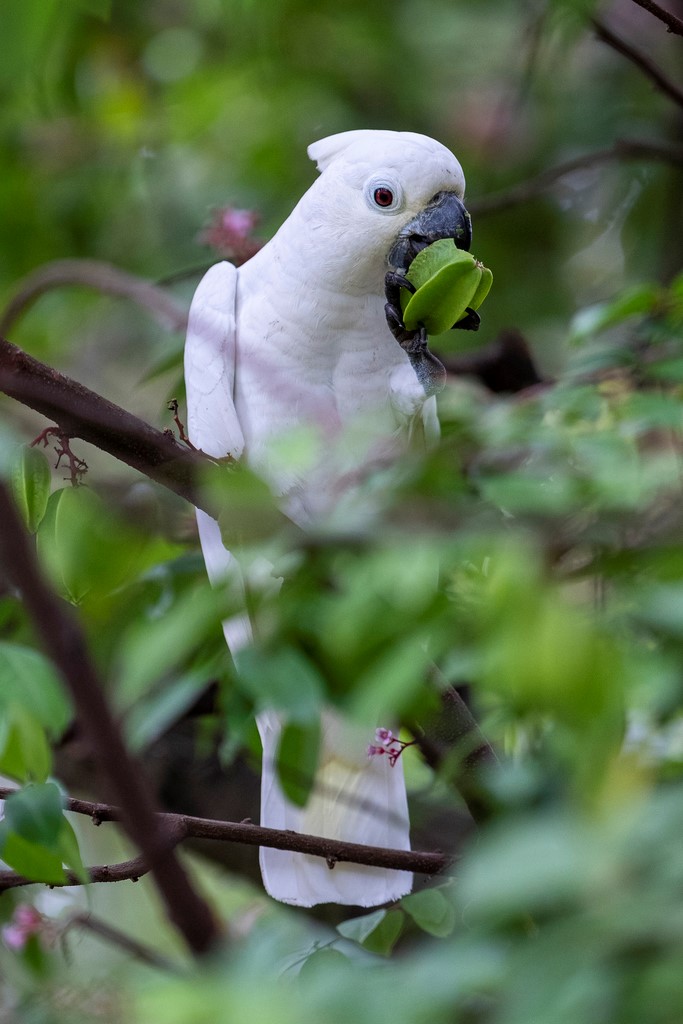
White Cockatoo, apparently a young bird with a short crest—appearing much like a Tanimbar Corella, but note the black bill with all-white feathering around its base. (Singapore; December 2019.) © Bryan Yeung
Both are mostly white and have conspicuous, saucer eyes—a big-eyed impression caused by their white orbital skin. White Cockatoo is somewhat larger overall, with longer crest feathers, and Tanimbar Corella usually has a detectable pinkish blush in its plumage. However, White Cockatoos sometimes appear off-white, and younger individuals can have shorter crests, whereas Tanimbar Corella sometimes appears white overall. The clearest difference between them is bill color: black on White Cockatoo and ivory or horn-colored on Tanimbar Corella. Also, Tanimbar Corella generally has detectable dull-pink coloration around the base of the bill, especially on the lores.
Additional Photos of Tanimbar Corella
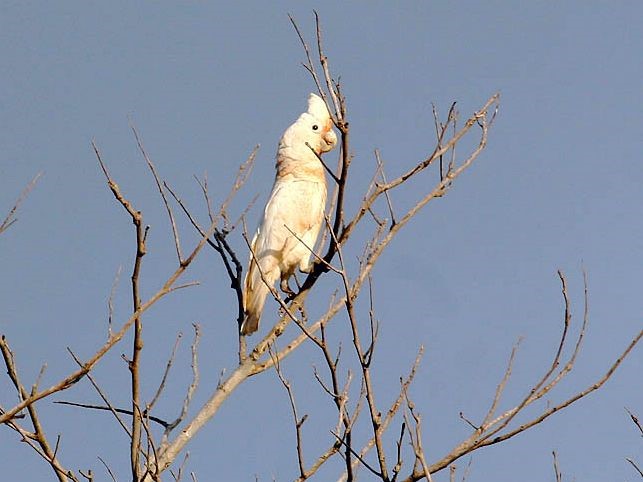
Tanimbar Corella with crest raised. (South of Saumlaki, Yamdena, Tanimbar Islands, Maluku, Indonesia; August 24, 2006.) © Mehd Halaouate
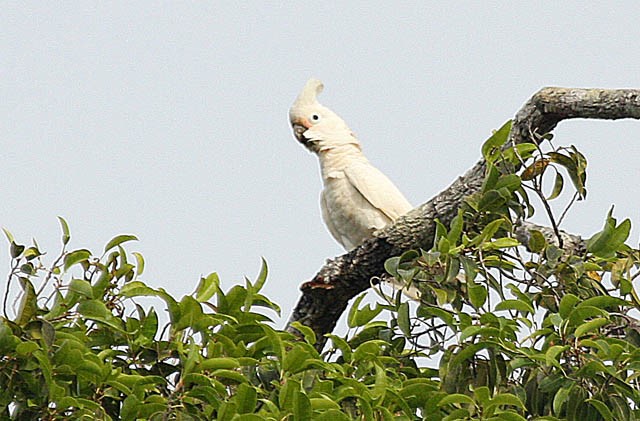
Tanimbar Corella with an apparently darker-than-usual bill. (Yamdena, Tanimbar Islands, Maluku, Indonesia; July 21, 2009.) © Jon Hornbuckle

Tanimbar Corella. (Singapore; July 1, 2015.) © Lars Petersson

Tanimbar Corella, pair, showing yellowing in undertail. (Bukit Brown Cemetery, Singapore; February 9, 2017.) © Marcel Finlay

Tanimbar Corella. (Sentosa Cove, Singapore; March 24, 2020.) © Choong YT
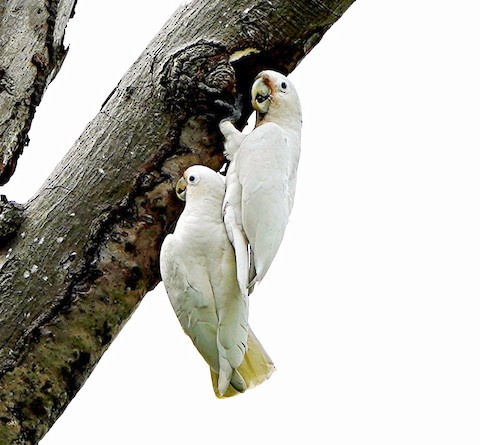
Tanimbar Corella, pair, showing yellow on upperside of tail. (Mount Rosie, Singapore; April 9, 2018.) © Steven Cheong
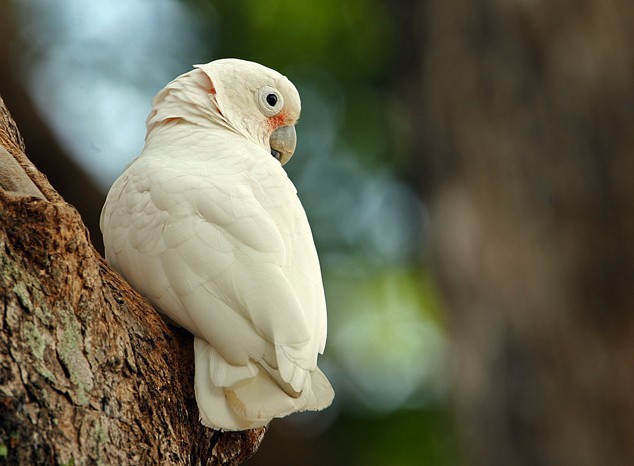
Tanimbar Corella. (Changi, Singapore; February 27, 2007.) © Mervin Quah
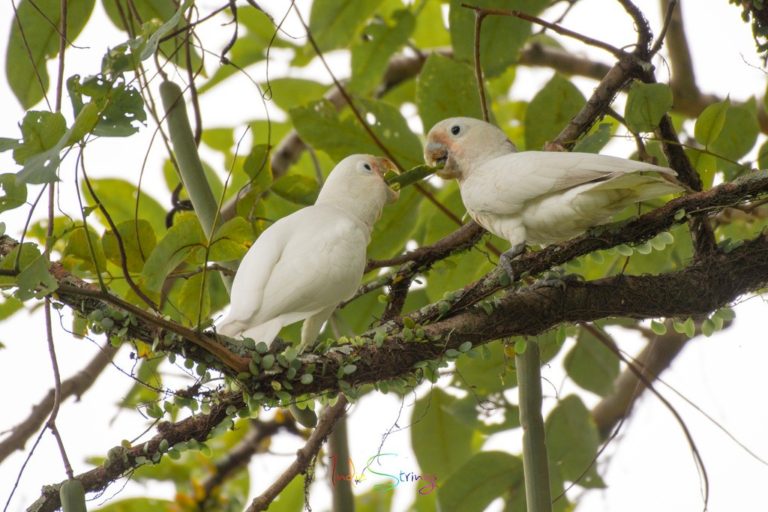
Tanimbar Corella, pair interacting. (Singapore; October 11, 2020.) © Bhupesh Kurade

Tanimbar Corella, pair interacting. (Singapore; November 28, 2018.) © Christine A. Chua
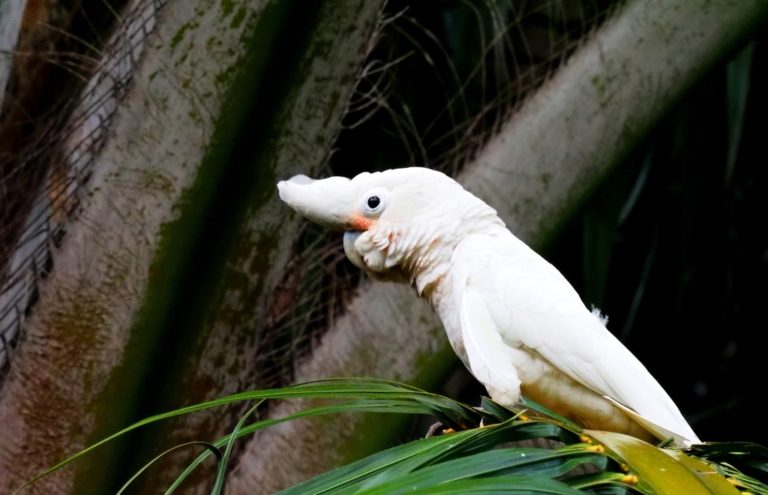
Tanimbar Corella with crest fully extended. (Singapore; April 21, 2018.) © tanhk
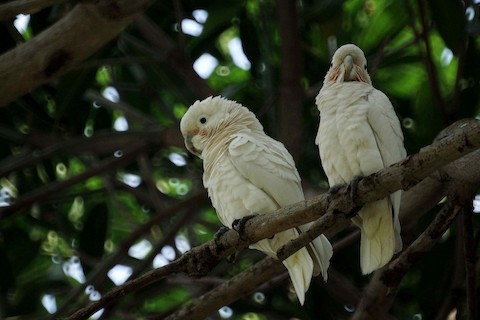
Tanimbar Corella. (Changi Beach Park, Singapore; March 16, 2018.) © Kian Guan Tay

Tanimbar Corella, pair, showing yellowing in undertail. (Bukit Brown Cemetery, Singapore; September 23, 2016.) © Marcel Finlay
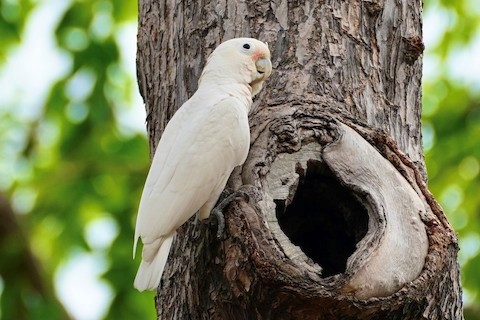
Tanimbar Corella. (Changi Beach Park, Singapore; August 24, 2019.) © Li Weng
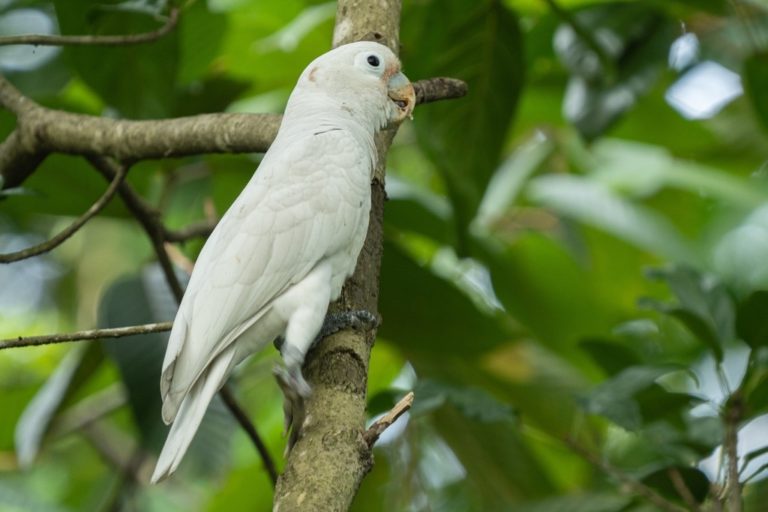
Tanimbar Corella. (Singapore; December 31, 2019.) © Jen Wei
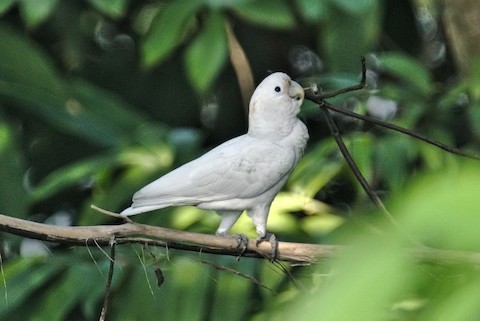
Tanimbar Corella. (Southern Ridges, Singapore; February 5, 2020.) © Kian Guan Tay

Tanimbar Corella. (Sentosa Island, Singapore; April 30, 2018.) © Monika Czupryna
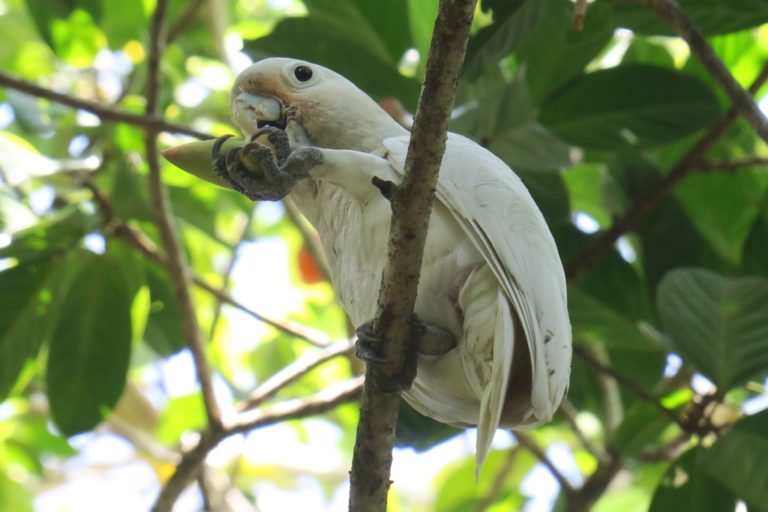
Tanimbar Corella. (Singapore; December 30, 2018.) © Soh Kam Yung
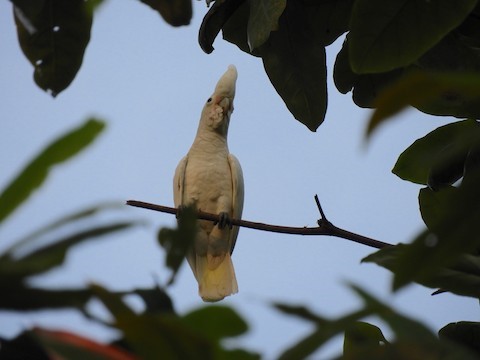
Tanimbar Corella with crest raised and showing yellow on undertail. (Changi Village, Singapore; July 17, 2019.) © Oliver Tan
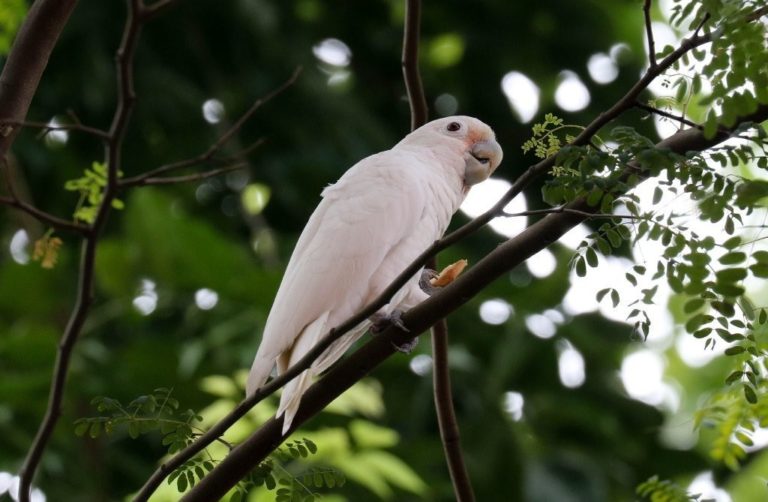
Tanimbar Corella, showing general pinkish blush. (Changi Village, Singapore; July 19, 2018.) © Hickson Fergusson
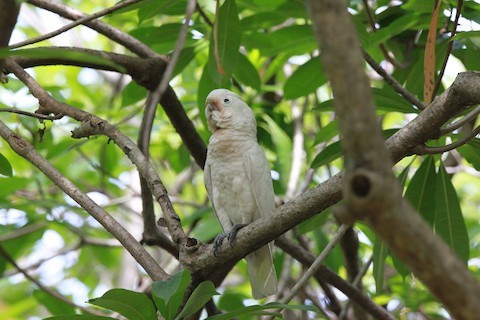
Tanimbar Corella. (Pasir Ris Park, Singapore; August 26, 2018.) © William Mahoney
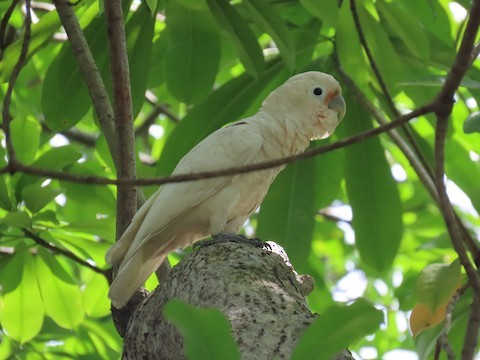
Tanimbar Corella. (Pasir Ris Park, Singapore; July 10, 2019.) © William Legge

Tanimbar Corella. (Singapore; December 30, 2018.) © Soh Kam Yung

Tanimbar Corella. (Sentosa Island, Singapore; February 16, 2018.) © Martin Kennewell
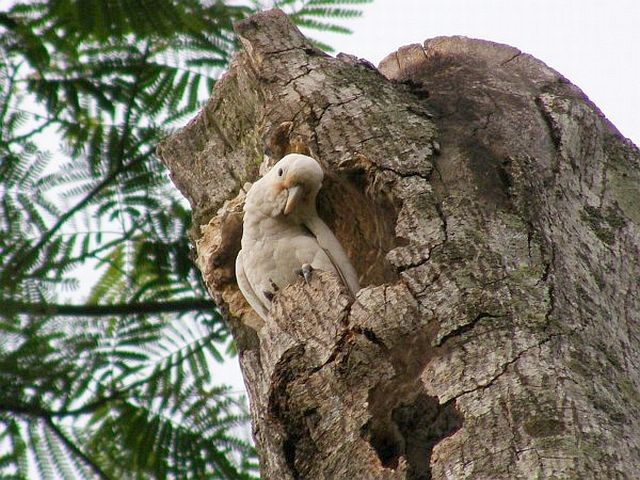
Tanimbar Corella, at nest cavity entrance. (Ragunan Zoo, South Jakarta, Java, Indonesia; August 5, 2009.) © Khaleb Yordan
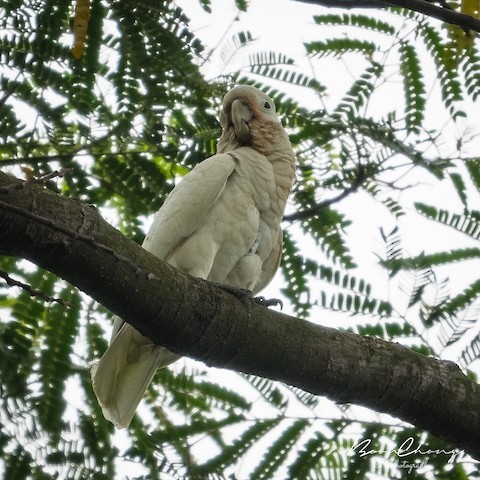
Tanimbar Corella. (Mount Rosie, Singapore; March 9, 2020.) © Boon Chong Chen
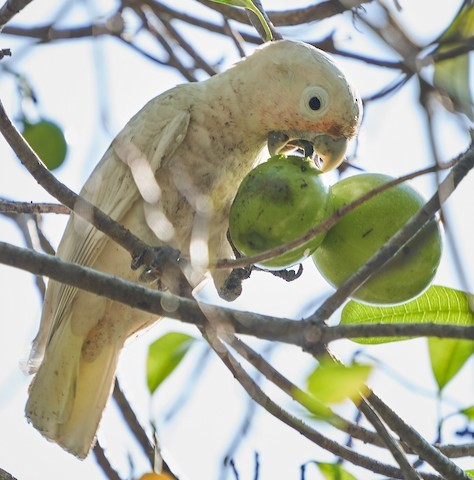
Tanimbar Corella. (Pasir Ris Park, Singapore; March 26, 2019.) © Steven Cheong

Tanimbar Corella. (Pasir Ris Park, Singapore; March 26, 2019.) © Steven Cheong
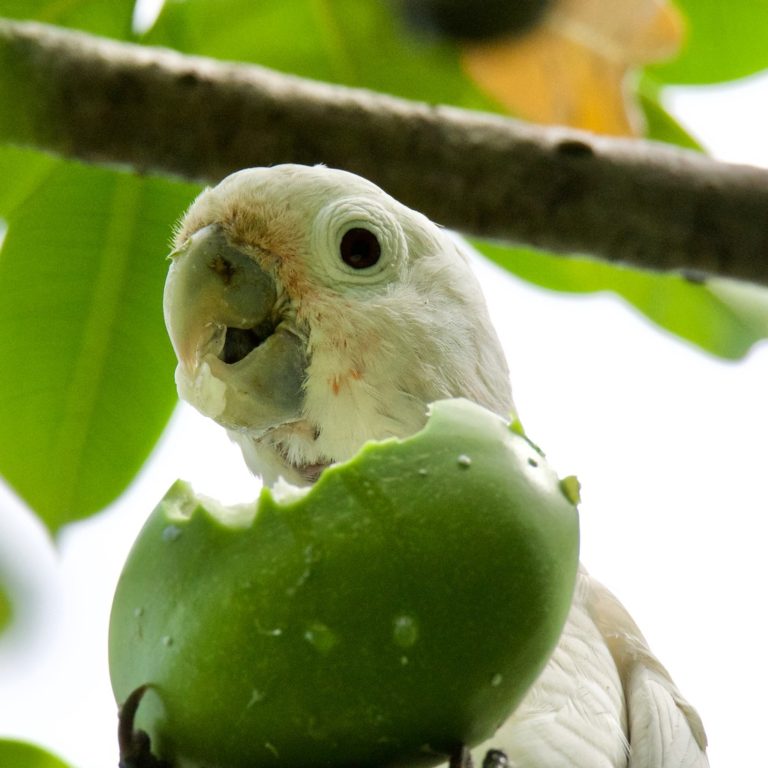
Tanimbar Corella. (Singapore; August 1, 2020.) © Hong Wenyang

Tanimbar Corella. (Singapore; August 1, 2020.) © Hong Wenyang
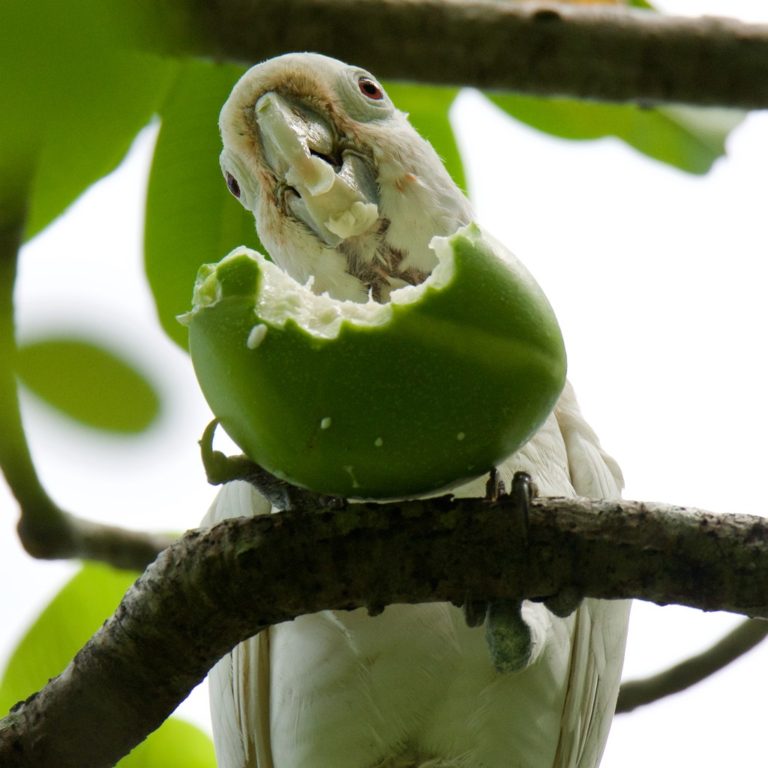
Tanimbar Corella. (Singapore; August 1, 2020.) © Hong Wenyang
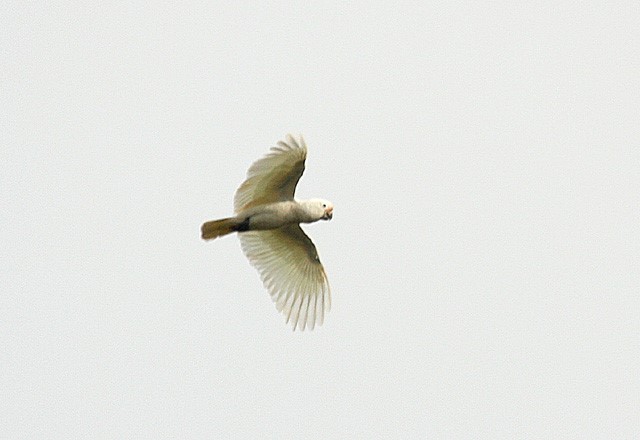
Tanimbar Corella. (Yamdena, Tanimbar Islands, Maluku, Indonesia; July 21, 2009.) © Jon Hornbuckle
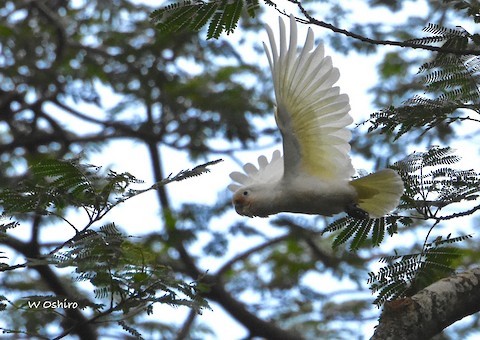
Tanimbar Corella, showing yellow on wings and tail. (Lyon Arboretum, Oahu, Hawaii; May 19, 2018.) © Walter Oshiro
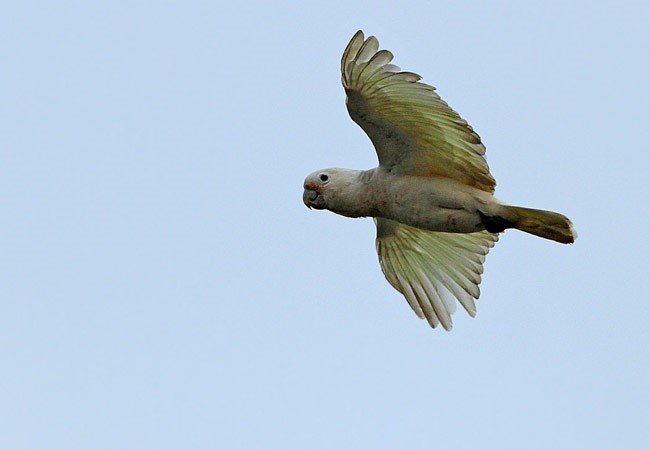
Tanimbar Corella, showing yellow on wings and tail. (Yamdena, Tanimbar Islands, Maluku, Indonesia; October 2014.) © James Eaton
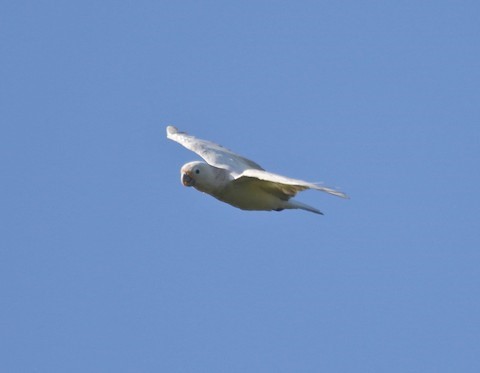
Tanimbar Corella. (Yamdena, Tanimbar Islands, Maluku, Indonesia.) © Gil Ewing
References
BirdLife International. 2018. Cacatua goffiniana. The IUCN Red List of Threatened Species 2018: e.T22684800A131915554. https://dx.doi.org/10.2305/IUCN.UK.2018-2.RLTS.T22684800A131915554.en. (Accessed October 17, 2020.)
Brazil, M. 2009. Birds of East Asia. Princeton University Press.
Cameron, M. 2007. Cockatoos. CSIRO Publishing, Collingwood, Victoria, Australia.
eBird. 2020. eBird: An online database of bird distribution and abundance. Cornell Lab of Ornithology, Ithaca, N.Y. http://www.ebird.org. (Accessed October 17, 2020.)
Forshaw, J.M. 2010. Parrots of the World. Princeton University Press.
Juniper, T., and M. Parr. 1998. Parrots: A Guide to Parrots of the World. Yale University Press.
Lin, R.S. and P.F. Lee. 2006. Status of Feral Populations of Exotic Cockatoos (Genus Cacatua) in Taiwan. Taiwania 51:188-194.
Michigan State University. 2020. AVoCet: Avian Vocalizations Center. https://avocet.integrativebiology.natsci.msu.edu/. (Accessed October 17, 2020.)
Mulawki, E.J. 2014. The Cockatoos: A Complete Guide to the 21 Species. McFarland Publishing, Jefferson, N.C.
Pyle, R.L., and P. Pyle. 2017. The Birds of the Hawaiian Islands: Occurrence, History, Distribution, and Status. Version 2 (January 1, 2017). http://hbs.bishopmuseum.org/birds/rlp-monograph/. B.P. Bishop Museum, Honolulu, Hawaii.
